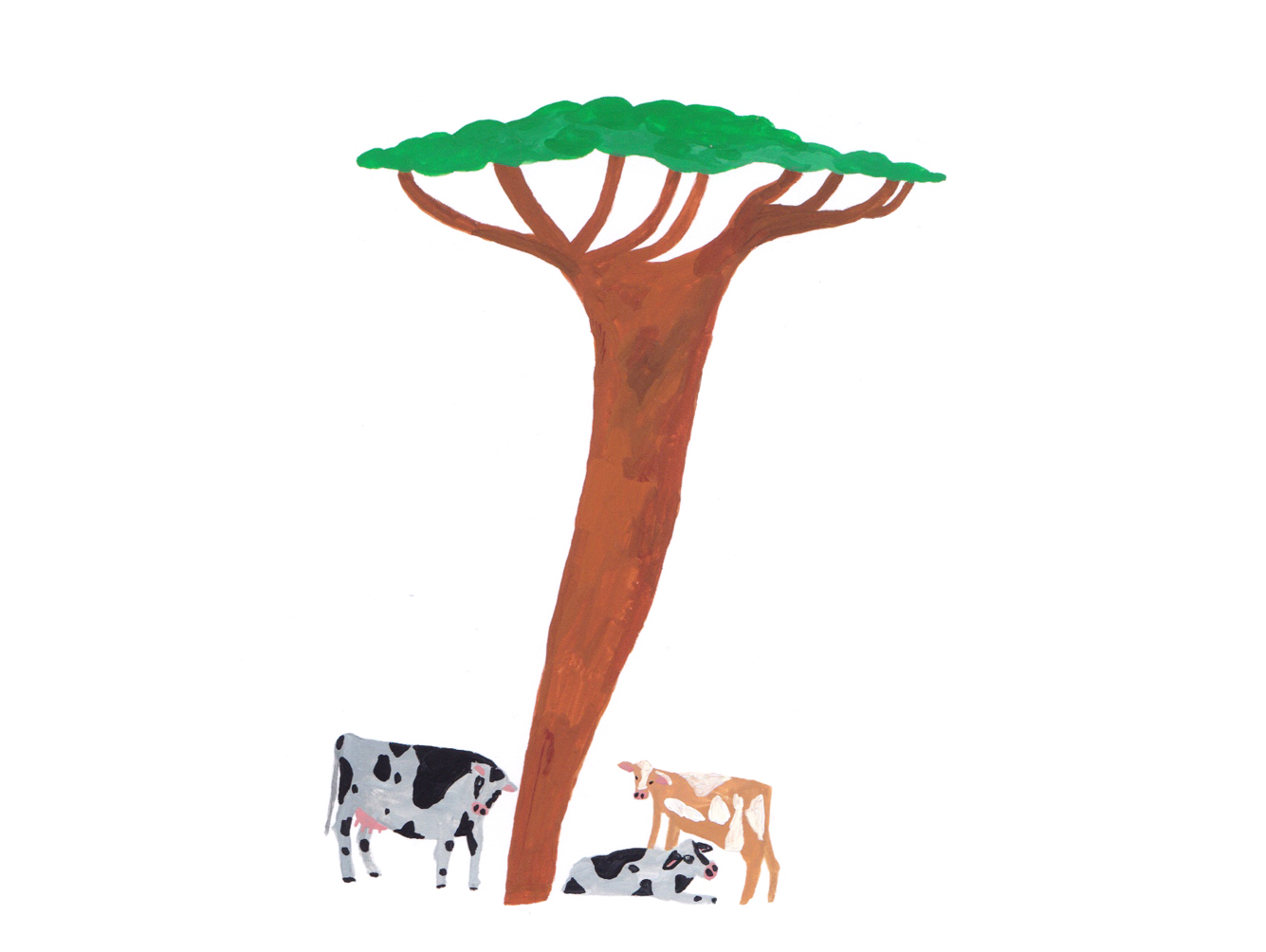An Illustrated Guide to Silvopasture
Words by Mathew Bate
Illustrations by Liz Rowland
This illustrated guide is featured in Issue 2. Order your copy or become a yearly subscriber today.
Planting trees on farms is a contentious topic. But although it might seem counterproductive, integrating trees and pasture can be a win-win. This illustrated guide to the ancient agricultural technique known as silvopasture, tells us how.
Silvopasture is the symbiotic integration of livestock grazing and forest management. This can either be achieved by strategically planting trees into a conventional, and usually treeless, grazing pasture or by thinning a wooded forest so that livestock can graze beneath its canopy. Silvopasture falls under the category of agroforestry as, importantly, silvopasture involves not only managing livestock but also the trees that are planted as well as the forage. An example being, most farmers plant trees that provide great forage for the livestock as well as longer-term benefits from the timber that can be milled.
What are the major benefits?
In a typical treeless pasture, livestock aren’t protected from high winds, heat and limited access to forage. It’s been proven that, when livestock are subjected to these pastures, they suffer, resulting in reduced agricultural output. Silvopasture provides ample windbreaks and shade, which in many cases can also increase forage yield. Generally, intensive silvopasture methods can more than double the production of milk and protein on the same area of land. Silvopasture methods also lower the variables that increase stress, which has been shown to affect the quality of meat. The leaves of many trees can also either be eaten by livestock or they produce nuts, such as acorns and walnuts, which are extremely high in protein. This lowers the need for farmers to buy external feed for their stock.
Silvopasture land sequesters five to ten times more carbon from the atmosphere than land of the same size that is treeless. One study of intensive silvopasture in Colombia found that emissions from livestock were less than half of the carbon sequestered in soil and biomass. This is because both the trees and the soil capture carbon.
Livestock also control weeds and their manure provides fertiliser, thereby reducing the need to use synthetic fertiliser, herbicides and pesticides. Also, because a high tree density improves soil health, moisture and mitigates erosion, the overall resilience of the land increases over time. Most grasses will actually do better and produce more digestible feed when shaded as well.
Why should we be doing it?
The Amazon is being destroyed to make way for livestock grazing, which accounts for 80 percent of total deforestation in the area. Livestock now occupy around 30 percent of the total land area on earth and are responsible for over 14 percent of the total greenhouse gas emissions caused by humans. Silvopasture has the ability to dramatically negate CO2 emissions while increasing agricultural efficiency, sequestering carbon, improving land quality and boosting ecological diversity.
Where is this happening?
Silvopasture has been a farming technique, especially in areas with high rainfall, since the beginning of agriculture. Recently, it has been championed in Columbia but it can also be found in heavily wooded areas of North America. It is estimated that 15 percent of the world’s grazing land uses silvopasture techniques. Silvopasture is usually confined to areas that have high enough rainfall and are humid enough to support ample tree growth. It is estimated that one fifth of our world’s 8.6 billion acres of grasslands are suitable for silvopasture.
How do we do it?
Farmers can either clear a heavily wooded area so that stock can graze in between the trees. Alternatively, farmers can plant trees in an empty pasture. This is usually a longer-term goal, as new trees can take up to five years to mature to a point where stock won’t destroy them. Trees can either be clumped, spread or planted in rows.
Research/statistics:
All of these elements led Drawdown, an extensive study by Paul Hawken into ways to reverse climate change, to conclude that silvopasture is the most effective agricultural production practice to reduce CO2 emissions. Remarkably, out of the top 100 ways to reduce CO2 emissions, silvopasture sits at number nine.
Drawdown estimated that silvopasture is currently practiced on 351 million acres of land globally. If this was increased to 554 million acres by 2050 then CO2 emissions could be reduced by 31.19 gigatons. To put this figure into perspective, Drawdown estimates that if seven percent of the world’s population had rooftop solar to power their houses it would avoid 24.6 gigatons of CO2 emissions.
It should also be mentioned that meat and dairy demand is growing, as is population growth. Silvopasture methods must be implemented alongside reduced meat and dairy intake and cutting back on food waste. Considering that reducing food waste and eating a plant-heavy diet are ranked third and fourth on Drawdown’s list, respectively, by changing the way we think about raising food, consuming it and disposing of it we can have profound effects on reducing and even reversing human-induced climate change. As individuals that eat every day, we can make daily decisions that, as a collective, can significantly mitigate climate change.














